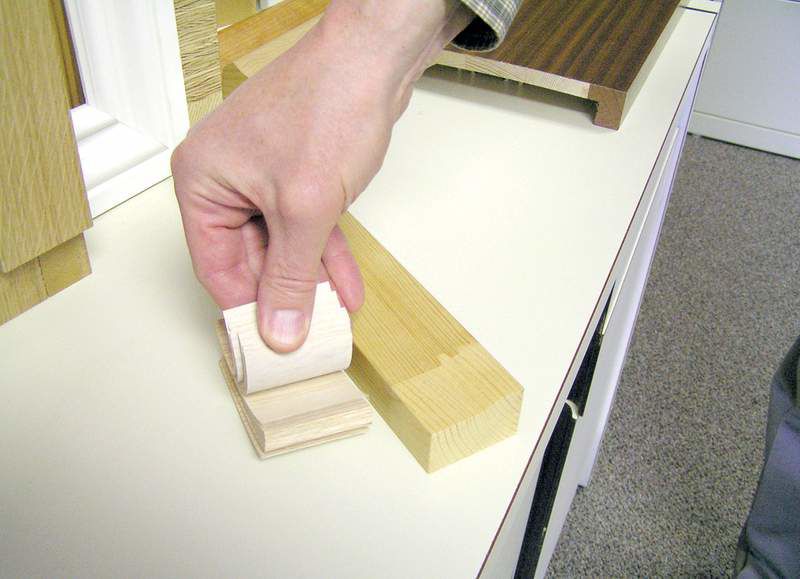Prineville company adapts
Published 5:00 am Monday, May 16, 2011

- Bob Horton of Contact Industries in Prineville thumbs through a stack of 50 cedar veneer strips made from a 2-by-2 chunk of solid cedar, like the one next to the stack of veneer strips. The veneers are wrapped onto aluminum frames to make fire-resistant door and window frames, moldings and other millwork.
Going green with development of high-tech products such as veneer-wrapped aluminum ceiling panels, soffits and window casings helped Contact Industries weather the housing market collapse and preserve 222 jobs in Prineville.
“With the foreclosure situation in the country, the number of new homes being built is very, very small, so we have had to broaden our market by going into architectural design products,” said Bob Horton, vice president of manufacturing at the Contact Industries plant in Prineville. “The mantra that’s pretty appropriate is ‘adapt or die.’”
Trending
Horton said the Prineville plant employed nearly 350 people at the peak of the housing boom in 2006 and 2007, manufacturing what he described as commodity or basic wooden door and window frames, molding and other millwork.
However, between the housing market collapse that hit the region in 2008 and a shift in production of the commodity wooden door and window frames and molding products to low-wage countries like China and India, Horton said the company had to go high-tech and change its product mix or face further job cuts and eventually the possible closure of the Prineville plant.
He said the future would have been far bleaker if Contact Industries’ owners, including President and CEO Frank Pearson and 30 other stockholders, hadn’t made substantial investments in new technology that allowed the company to add a line of veneer-wrapped aluminum products that help reduce harvests of scarce woods and improve fire safety for homes, schools, government and commercial buildings and cruise ships.
“We owe the owners a lot for being willing to invest in new technology and new processes during a time when it took courage to invest in the wood products industry,” Horton said. “If we had stayed in the original commodity products, I think it would have been tough for us to make it.”
Over the past five years, Contact Industries has developed more than 100 new products, most of which were developed to meet architectural specifications for specific projects, he said.
Aside from the economic benefits of expanding into veneer-wrapped aluminum products, Horton said “using veneer is actually a very green thing to do.”
Trending
For example, he said a 12-foot-long cedar 2-by-2 might make one piece of solid wood molding, but when that same piece of cedar is sliced into 50 layers of laminate, the strips can be used to make 50 pieces of veneer-wrapped aluminum molding.
“As some woods are very scarce, the veneer process really stretches the resource,” Horton said. “It’s good for the environment.”
To make a successful transition to the veneer-wrapped aluminum products, Horton said the company targeted architectural design products, which are initially built to specifications for individual projects, such as veneer-wrapped aluminum crown moldings for a cruise ship, veneer-wrapped aluminum soffits for the University of California and veneer-wrapped ceiling panels for buildings at the San Jose Airport.
“We have learned how to do things like flame-spread testing so we can make wood veneer-wrapped aluminum products that meet the fire-safety specifications of the architects,” said Horton, who has worked at the Prineville plant since 1995.
“Developing new products is the primary job of all of us in leadership at Contact Industries,” Horton said. “I think having an intense focus on developing new green products that meet the current safety requirements and architectural design specifications are the main reasons we are still here in Prineville.”
Some of the company’s other veneer-wrapped aluminum products developed over the past five years include tongue-and-groove paneling, window louvers and art frames.
“We are not your father’s lumber mill,” Horton said. “We have moved into the high-tech end of the wood products realm.”
Evolving with the times
Contact Industries, headquartered in Clackamas, originated in 1946 as a lumber brokerage firm. Horton said the company has operated plants of one kind or another at the Prineville site since 1954, beginning with potato shed, and later as a wood molding manufacturing business called Clear Pine Molding during the 1960s, ’70s and ’80s. The name was changed to Contact Lumber in the 1990s and to Contact Industries in the early 2000s to better reflect the new direction for the company’s 21st Century green products made with veneers-wrapped aluminum, according to Horton and information on the company’s website, www.contactind.com.
“The name Clear Pine implied old growth lumber. We are anything but old growth. We are a secondary wood products manufacturer. We are not about old growth lumber and with the newer veneer and aluminum products we are not about commodity lumber or molding, so we changed the name to Contact Industries,” Horton said.
Benefits of veneers
Horton said the veneer-wrapped aluminum products have the look and feel of solid wood because the thin layer of real wood is what people see, but when wood veneers are wrapped around a solid aluminum structure, it creates a stronger, lighter and more fire-resistant product.
“It’s lightweight and it is not going to burn,” Horton said.
Because the veneer-wrapped aluminum products are so much lighter than solid wood, shipping costs are far lower, so less energy is used to transport them from the manufacturing plant in Prineville to building sites and shipyards around the country and around the world, Horton said.
“This technology is not always the cheapest, but it certainly does things you can’t do with solid wood,” he said.
In addition to the wood veneer-wrapped products, Horton said Contact Industries is also involved in developing wood grain photos of veneers used in place of real wood veneers for coating aluminum moldings and other millwork for King’s College in Great Britain.
“With the photo veneer you can have a great-looking product with no maintenance, and you don’t have to worry about the sun fading it, like you do with real wood,” Horton said.
By shifting more of the company’s production to products made with real wood veneers and wood grain photo veneers, Contact Industries has lessened its dependence on unpredictable timber sales on National Forest lands, Horton said.








